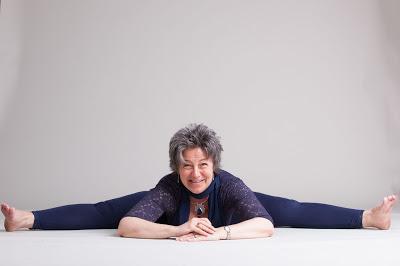
Wendy Sansjo, Age 55, of Adaptive Yoga Scandinavia
(photo by Lars Iverson)
1. Flexion: Moving your leg in toward the front of your lower torso or bringing the front of your lower torso toward your leg (a forward bend in your hips). For example, lifting your leg up in Standing Hand to Foot pose (Hasta Padangustasana) or Reclined Standing Hand to Foot pose (Supta Padangusthasana), stepping one leg forward and bending that knee as in Warrior 1 (Virabrdrasana 1) or tipping the hips forward over the leg Pyramid pose (Pasvottanasana). 2. Extension: Moving your leg back toward the back of your lower torso or bringing the back of your lower torso toward your leg (a backbend in your hips). For example, when you step your back leg back into Warrior 1 or lift your legs up in Locust pose (Salabasana). 3. Abduction: Moving your leg to the side, away from the midline of your body. For example, when you step both legs out to the sides from Mountain pose (Tadasana) into the wide-leg stance for a standing pose such as Triangle pose (Trikonasana).4. Adduction: Moving one leg across the other, as in Eagle pose (Garudasana), or moving a leg that was out to the side back toward the midline of the body, such as stepping back into Mountain pose from a wide-leg stance. 5. External Rotation: Turning your leg out within your hip socket so the leg turns away from the midline of your body. For example, when setting up your front foot position for Triangle pose, you externally rotate your front leg as you turn your front foot out to 90 degrees before entering the full pose. This movement is almost always combined with one or more of the others listed above.6. Internal Rotation: Turning your leg in within your hip socket so the leg turns toward the midline of your body. For example, when you are setting up your back foot position for Triangle pose, you internally rotate your back leg as your turn your back foot slightly inward. This movement is almost always combined with one or more of the others listed above.
Cautions
Now let’s look at who should avoid or minimize certain hip movements. Keep in mind, however, that we want to maintain as much of our full range of movement of the hip joint as possible. So, in many instances, my caution will not mean “don’t” or “never,” but rather approach cautiously and stop if the movement worsens pain. In general, you should avoid or minimize any hip movement if you have:
- Acute painful injury to the hip area that gets worse with that movement.
- Chronic issues that flare with that movement, such as those with hip arthritis, joint replacement or surgically repaired hip fractures, or labral tears of the hip joint.
- Those with certain types of hip replacement (check with your surgeon) may have to avoid flexion beyond 90 degrees from standing position.
- Those with acute hamstring tears, especially those at the attachment at the sitting bone, at least for several weeks.
- Those with acute tears of the uppermost part of quadraceps muscle (the rectus femoris), acute strain of the psoas, iliacus, or the other front groin muscles (as in a “groin pull”).
- Those with acute muscle strain to the inner thigh muscles (the known as the adductors), which get stretched via abduction.
- Those with separation of the pubic symphysis, a rare situation sometimes seen in post-partum women or cases of severe trauma to the pelvis.
- Those with acute trauma or surgical repair to the perineum/pelvic floor.
- Those with acute bursitis of the outer hips (greater trochanter area).
- Those with large hernias in the groin area if adduction causes pain.
- Those with a hip replacement that could become dislocated by this movement (check with your surgeon) or a history of dislocating hips.
- Those with painful compression of the soft tissues caused by scissoring of the legs past one another (more common for men than women)
- Those with a hip replacement that could become dislocated by this movement (check with your surgeon) or those with a past history of dislocation with this action.
- Those with an older, posterior approach method of hip replacement (check with your surgeon) or those with a past history of dislocation with this action.

